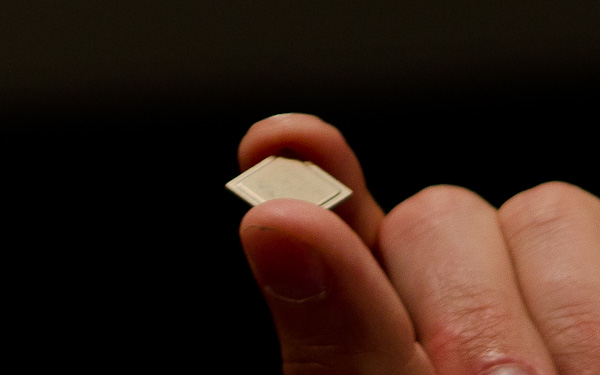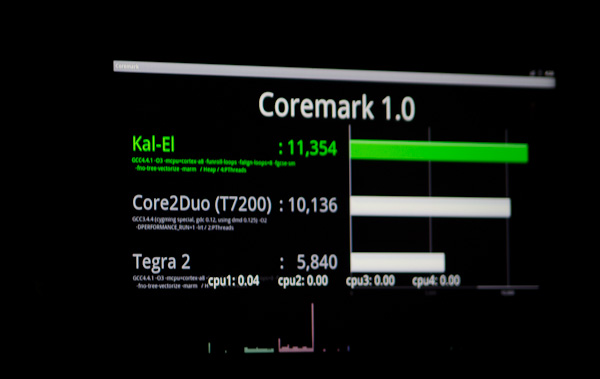NVIDIA's Project Kal-El: Quad-Core A9s Coming to Smartphones/Tablets This Year
by Anand Lal Shimpi on February 15, 2011 9:05 PM ESTFinal Words
The first thing everyone at NVIDIA asked me after I saw Kal-El running was an eager and expected: "well, what did you think?"
On the one hand, we have a clear underdog in the SoC space demonstrating a brand new chip just 12 days after getting it back from the fab. It's functional, it can render 3D games, it can decode high bitrate video and it runs Android today. The word impressive is insufficient to convey the magnitude of what I just described, particularly in the SoC space.
On the other hand, it's still just an announcement. It wasn't too long ago that NVIDIA was struggling to name a single design win. The recent success with LG, Motorola and Samsung is awesome, but it isn't a guarantee of what's to come. That being said, the handset vendors and carriers clearly take NVIDIA seriously today and they would be foolish not to consider Kal-El as it'll be the quickest way to get to quad-core in an Android phone.
Architecturally, Kal-El isn't a huge departure from what we currently have today with Tegra 2. NVIDIA claims a 5x performance improvement over Tegra 2 however that seems a bit optimistic. The 5x gains appear to be from combining the 2x theoretical gain from 2 to 4 cores plus a 3x gain from the new GPU. NVIDIA claims that this is enough to put Kal-El above a Core 2 Duo clocked at 2GHz (see the test results below), however the NVIDIA generated scores seem suspect not to mention that Coremark isn't representative of the sort of workload you'd see on a smartphone/tablet.
If NVIDIA can increase clock speeds a bit we'll see better performance than Tegra 2 on lightly threaded workloads, but I'm not convinced of the gains to be had in single-tasking workloads from four cores in a smartphone/tablet. The bigger gains over Tegra 2 will likely come from any improvements to the memory controller as well as the faster GPU. This being said, NVIDIA does believe that even web page rendering can benefit significantly from a quad-core CPU so I could be very well proven wrong once devices are out in the wild.
If NVIDIA can secure significant design wins with Kal-El based tablets in August of this year and smartphones in Q4 I will be beyond impressed. NVIDIA gets major points for putting on good demos of working silicon today but in this business you need to have devices. For now we play the waiting game. I suspect if you're not taking NVIDIA seriously at this point, you really should be.












76 Comments
View All Comments
B3an - Wednesday, February 16, 2011 - link
Android 2.3 finally, FINALLY has GPU acceleration. So the Samsung Galaxy S2 will have it for instance.I totally agree with you though, Google should have had GPU acceleration a long time ago, most people i know who have iPhones complain about the choppiness of Android when scrolling/animating.
Windows Phone 7 actually has the smoothest OS of them all though, it's so well polished. MS done it literally perfectly on the first release. Android takes many versions to fix this, and it's still not as good, but atleast GPU acceleration is there now.
Lucian Armasu - Wednesday, February 16, 2011 - link
Only Honeycomb has full hardware acceleration. Android 2.3 has better garbage collection that has improved the speed of the UI a bit.AbRASiON - Wednesday, February 16, 2011 - link
Someone listen to this guy!I love my Android phone but god damnit even a half decent one is a little laggy and sluggish at points.
The iphone sucks in a lot of silly ways but it's always a smooth and consistent feel, even if it fakes it - they are clever about it.
BlueScreenJunky - Wednesday, February 16, 2011 - link
Well according to the sales figures that doesn't prevent Android phones from selling well so I don't see a problem from Google and the manufacturers' point of view.And from my point of view that's absolutely no problem at all : Since I like my phone to be responsive and I dont need 50 widgets I only have one home screen (So I can't swipe through anything) and I disabled every single animation using spareparts...
So there's nothing left to accelerate really and now when I use a phone with the animations enabled I'm like "Why do I have to look at the page sliding or zooming in before I can actually begin to read ? It's just a waste of time !"
Aloonatic - Monday, February 21, 2011 - link
I guess you just eat protein and vitamin pills etc? What's the point in making tasty food and chewing it? It's just a waste of time.I guess it's good that you are happy to live in a bland little world, but most people aren't and whether you realise that it's an issue or not, but one of the reasons why many people love LOVE (LOVE!!!!!) their Apple devices, and why they still have a strong presence in the market in spite of their price premium is because they have realised that the swoop, expanding, sliding animations make using their devices a far more fun experience, rather than just being a dull utilitarian device.
You might be happy with what you have, but I think you're in a teeny, tiny minority when the entire market (ie not just techies) is taken into account and that's where the money is to be made. Expect Android and WinMo to try to emulate Apple as much as possible, because if they don't, they will always struggle to lure people, their wallets and their personal data that they might want to mine, away from Apple.
softdrinkviking - Wednesday, February 16, 2011 - link
If extra cores make browsing buttery-smooth, I'm all for it.They shouldn't be drawing extra power from your phone unless they are getting some tangible use anyway. (that is assuming some level of power-gating)
I like GPU acceleration too, but there is no reason to ditch a wider architecture because it's effects are not immediately discernible by people browsing phones in the verizon store.
tviceman - Tuesday, February 15, 2011 - link
The similarities with Nvidia's first products are strikingly similar to it's venture into the mobile space. Insofar as being a success,Tegra1 = NV1 (not successful at all)
Tegra2 looks like it has become the RIVA 128 - huge turn around and very competitive.
Tegra3 (Kal-El) could end up being the RIVA TNT/ TNT2 and the transition to 28nm (probably Wayne) could propel Nvidia to being the #1 mobile CPU manufacturer ---- much like what GeForce did for Nvidia.
djgandy - Wednesday, February 16, 2011 - link
Well they haven't sold anything yet. It's business as usual at Nvidia, delivering lots of hype and marketing.Considering they struggle to keep their desktop parts running cool and with low power, maybe people should focus on the key aspect of a mobile chip, battery life, rather than salivating over cherry picked CPU benchmarks and potential GPU performance which is already out there in pocket melting form.
bplewis24 - Wednesday, February 16, 2011 - link
They already have an article discussing Tegra2's battery life performance.Brandon
tim851 - Tuesday, February 15, 2011 - link
What does Nicolas Cage's son have to do with all of this?